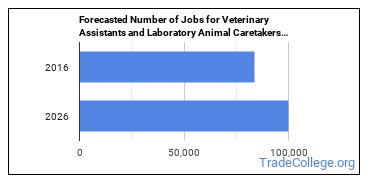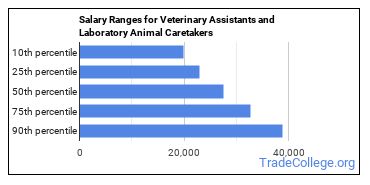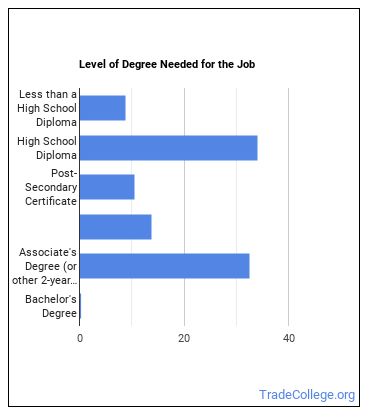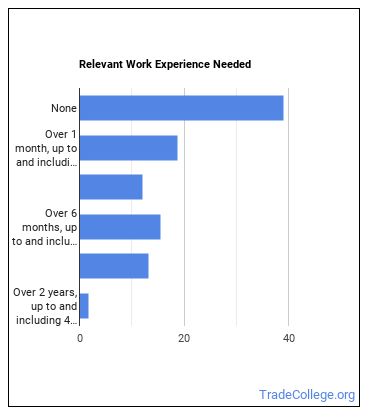Find Trade Colleges
What Does it Take to Be a Veterinary Assistant or Laboratory Animal Caretaker?
Career Description Feed, water, and examine pets and other nonfarm animals for signs of illness, disease, or injury in laboratories and animal hospitals and clinics. Clean and disinfect cages and work areas, and sterilize laboratory and surgical equipment. May provide routine post-operative care, administer medication orally or topically, or prepare samples for laboratory examination under the supervision of veterinary or laboratory animal technologists or technicians, veterinarians, or scientists.
Life As a Veterinary Assistant: What Do They Do?
- Perform accounting duties, such as bookkeeping, billing customers for services, or maintaining inventories.
- Exercise animals or provide them with companionship.
- Dust, spray, or bathe animals to control insect pests.
- Administer anesthetics during surgery and monitor the effects on animals.
- Examine animals to detect behavioral changes or clinical symptoms that could indicate illness or injury.
- Sell pet food or supplies to customers.
Featured schools near , edit
What Skills Do You Need to Work as a Veterinary Assistant?
These are the skills Veterinary Assistants and Laboratory Animal Caretakers say are the most useful in their careers:
Active Listening: Giving full attention to what other people are saying, taking time to understand the points being made, asking questions as appropriate, and not interrupting at inappropriate times.
Monitoring: Monitoring/Assessing performance of yourself, other individuals, or organizations to make improvements or take corrective action.
Service Orientation: Actively looking for ways to help people.
Social Perceptiveness: Being aware of others’ reactions and understanding why they react as they do.
Speaking: Talking to others to convey information effectively.
Coordination: Adjusting actions in relation to others’ actions.
Related Job Titles
- Veterinarian Helper
- Animal Care Provider
- Animal Caretaker
- Veterinary Attendant
- Small Animal Caretaker
Is There Going to be Demand for Veterinary Assistants and Laboratory Animal Caretakers?
There were about 83,800 jobs for Veterinary Assistant or Laboratory Animal Caretaker in 2016 (in the United States). New jobs are being produced at a rate of 19.3% which is above the national average. The Bureau of Labor Statistics predicts 16,200 new jobs for Veterinary Assistant or Laboratory Animal Caretaker by 2026. Due to new job openings and attrition, there will be an average of 15,500 job openings in this field each year.

The states with the most job growth for Veterinary Assistant are Utah, Nevada, and North Dakota. Watch out if you plan on working in Ohio, Maine, or Maryland. These states have the worst job growth for this type of profession.
How Much Does a Veterinary Assistant Make?
The salary for Veterinary Assistants and Laboratory Animal Caretakers ranges between about $19,950 and $38,890 a year.

Veterinary Assistants and Laboratory Animal Caretakers who work in Massachusetts, Maine, or Alaska, make the highest salaries.
How much do Veterinary Assistants and Laboratory Animal Caretakers make in different U.S. states?
| State | Annual Mean Salary |
|---|---|
| Alabama | $23,950 |
| Alaska | $32,170 |
| Arizona | $29,300 |
| Arkansas | $25,640 |
| California | $32,480 |
| Colorado | $30,510 |
| Connecticut | $34,850 |
| Delaware | $27,750 |
| Florida | $27,450 |
| Georgia | $25,980 |
| Hawaii | $30,050 |
| Idaho | $27,420 |
| Illinois | $28,060 |
| Indiana | $28,750 |
| Iowa | $28,410 |
| Kansas | $28,680 |
| Kentucky | $25,380 |
| Louisiana | $24,310 |
| Maine | $34,680 |
| Maryland | $29,280 |
| Massachusetts | $36,720 |
| Michigan | $26,800 |
| Minnesota | $29,830 |
| Mississippi | $23,350 |
| Missouri | $28,110 |
| Montana | $27,000 |
| Nebraska | $27,640 |
| Nevada | $28,010 |
| New Hampshire | $27,730 |
| New Jersey | $29,960 |
| New Mexico | $25,030 |
| New York | $32,320 |
| North Carolina | $28,830 |
| North Dakota | $25,120 |
| Ohio | $26,380 |
| Oklahoma | $25,080 |
| Oregon | $30,850 |
| Pennsylvania | $28,840 |
| Rhode Island | $24,850 |
| South Carolina | $25,450 |
| South Dakota | $24,610 |
| Tennessee | $24,960 |
| Texas | $26,410 |
| Utah | $24,750 |
| Vermont | $30,400 |
| Virginia | $26,750 |
| Washington | $31,180 |
| West Virginia | $24,050 |
| Wisconsin | $26,870 |
| Wyoming | $29,190 |
Tools & Technologies Used by Veterinary Assistants and Laboratory Animal Caretakers
Below is a list of the types of tools and technologies that Veterinary Assistants and Laboratory Animal Caretakers may use on a daily basis:
- Microsoft Excel
- Microsoft Word
- Microsoft Office
- Microsoft PowerPoint
- Microsoft Outlook
- Microsoft Access
- Word processing software
- Scheduling software
- Practice management software PMS
- Labeling software
- IDEXX Laboratories IDEXX Cornerstone
- McAllister Software Systems AVImark
How do I Become a Veterinary Assistant?
Learn what Veterinary Assistant or Laboratory Animal Caretaker education requirements there are.

How Long Does it Take to Become a Veterinary Assistant?

Other Jobs You May be Interested In
Those thinking about becoming a Veterinary Assistant or Laboratory Animal Caretaker might also be interested in the following careers:
Career changers with experience as a Veterinary Assistant or Laboratory Animal Caretaker sometimes find work in one of the following fields:
References:
More about our data sources and methodologies.
